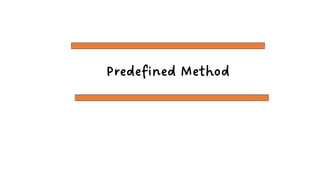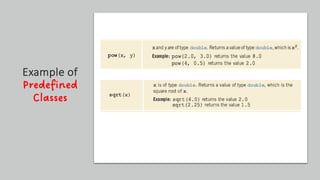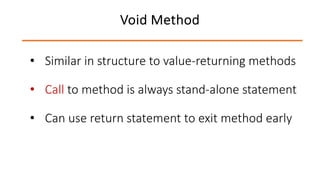Ad
Week 7 Java Programming Methods For I.T students.pdf
- 1. Java Methods Week 7 Objective: To apply predefined and user defined methods in Java programming.
- 2. What is a Method in Java? • Is a block of code or collection of statements or a set of code grouped together to perform a certain task or operation. • Used to achieve a reusability of code. This means that a method can written once and use it many times.
- 3. What is a Method in Java? • Provides easy modification and readability of code by adding or removing a chunk of code. • It is executed only when we call or invoke it. • The most important method in java is the main() method.
- 4. Types of Method • Predefined Method • User-defined Method
- 6. What is a Method in Java? Predefined Method Methods already written and provided by Java Organized as a collection of classes (class libraries) To use: it needs an import package Method Type: data type of value returned by method
- 7. Predefined Method Are the method that is already defined in Java class libraries. Also known as standard library method or built-in method.
- 10. User-Defined Methods The method written by the user or programmer This method is modified according to the requirement
- 11. Types of User-Defined Method Ø Non – value returning method Ø Value returning method Ø Methods Overloading
- 12. • When the method returns nothing, the return keyword at the end of the method is optional. • It uses void keyword. • Similar in structure to value-returning methods Non - Value Returning Method
- 13. • Similar in structure to value-returning methods • Call to method is always stand-alone statement • Can use return statement to exit method early Void Method
- 14. Syntax of Creating a method without a return value public static type name() { // method boy or method signature } Access Specifier Return Type Method Name Method Header
- 15. Example of a User-Defined Method public class Method { public static void display() { System.out.println("Hi Java"); } public static void main(String[] args) { // call or invoke the Method display(); } // end of main }//end of class
- 16. public class Method { public static void display() { System.out.println("Hi Java"); } public static void main(String[] args) { // call or invoke the Method display(); } // end of main }//end of class
- 18. • Calculate and return a value • Used to save value for later calculation or print value • Uses a return keyword. Value Returning Method
- 20. public class Method { public static int sum(int x, int y) { int sum = x + y; System.out.println("Sum = "+sum); return sum; } public static void main(String[] args) { Scanner input = new Scanner(System.in); int a, b; System.out.print("Enter value for a:"); a = input.nextInt(); System.out.print("Enter value for b:"); b = input.nextInt(); sum(a,b); } }
- 21. Variable x, y are arguments or known as the actual parameters; Variable a ,b are known as format parameters;
- 22. Naming a Method • remember that the method name must be a verb and start with a lowercase letter. • If the method name has more than two words, the first name must be a verb followed by adjective or noun. • In the multi-word method name, the first letter of each word must be in uppercase except the first word. Example: • Single-word method name: sum(), area() • Multi-word method name: computeCircle(), calculateArea()
- 23. Naming a Method • It is also possible that a method has the same name as another method name in the same class, it is known as method overloading
- 24. Primitive Type Wrapper Classes as Parameters • If a formal parameter is of the primitive data type and the corresponding actual parameter is a variable, then the formal parameter cannot change the value of the actual parameter • Only reference variables can pass values outside the method (except, of course, for the return value) • Corresponding to each primitive data type, Java provides a class so that the values of primitive data types can be wrapped in objects • The class Integer does not provide a method to change the value of an existing Integer object • The same is true of other wrapper classes
- 25. Reference Variables as Parameters • If a formal parameter is a reference variable: • Copies value of corresponding actual parameter • Value of actual parameter is address of the object where actual data is stored • Both formal and actual parameter refer to same object
- 26. Use Reference Variables as Parameters • Can return more than one value from a method • Can change the value of the actual object • When passing address, would save memory space and time, relative to copying large amount of data
- 27. Method Overloading • Method Overloading: is creating several methods within a class, with the same name. • The signature of the method consists of the method name and its formal parameter list • Two methods have different signatures if they have either different names or different format parameter lists • Note that the signature of a method does not include the return type of the method
- 28. Method Overloading - by changing the number of arguments
- 29. Method Overloading - by changing the data types
- 30. Debugging: Using Drivers and Stubs • A program may contain a number of methods. In a complex program, usually, when a method is written, it is tested and debugged alone. • You can write a separate program to test the method. The program that tests a method is called a driver program. • Before writing the complete program, you could write separate driver programs to make sure that each method is working properly.
- 31. Summary • Sometimes the results calculated by one method are needed in another method. • In that case, the method that depends on another method cannot be tested alone. • A method stub is a method that is not fully coded. • For a void method, a method stub might consist of only a method header and a set of empty braces, {}. • For a value-returning method it might contain only a return statement with a plausible return value.
- 32. • If the problem is large and complex, it must be broken into subproblems, and if a subproblem is still complex, it must further be divided into subproblems. • The subdivision of a problem should continue to the point where the solution is clear and obvious. • Once a subproblem is solved, we can continue with the solution of another subproblem and if all the subproblems of a problem are solved, we can continue with the next level. • Eventually, the overall solution of the problem must be assembled and tested to ensure that the programming code accomplishes the required task.
- 33. • A Java program is a collection of classes, and a class is a collection of data members and methods. • Each class and each method must work properly. • To accomplish this, as explained in the previous section, once a method is written, it can be tested using stubs and drivers. • Since a method can be tested in isolation, it is not necessary to code all the methods in order. • Once all the methods are written, the overall program must be tested.
- 34. • The technique to solve a problem by subdividing into smaller problems is known as divide and conquer and top-down design approach. • These techniques are suitable and work for many kinds of problems, including most of the problems given in this book and the problems you will encounter as a beginning programmer. • To simplify the overall solution of a problem that consists of many subproblems, we write and test the code one piece at a time. • Typically, once a subproblem is solved and the code is tested, it is saved as the first version or a version of the program. • We continue to add and save the program one piece at a time. Keep in mind that a working program with fewer features is better than a nonworking one with many features.














![Example of a
User-Defined
Method
public class Method {
public static void display()
{
System.out.println("Hi Java");
}
public static void main(String[] args) {
// call or invoke the Method
display();
} // end of main
}//end of class](https://image.slidesharecdn.com/week7javamethods-250501135535-24530ba9/85/Week-7-Java-Programming-Methods-For-I-T-students-pdf-15-320.jpg)
![public class Method {
public static void display()
{
System.out.println("Hi Java");
}
public static void main(String[] args) {
// call or invoke the Method
display();
} // end of main
}//end of class](https://image.slidesharecdn.com/week7javamethods-250501135535-24530ba9/85/Week-7-Java-Programming-Methods-For-I-T-students-pdf-16-320.jpg)



![public class Method {
public static int sum(int x, int y)
{
int sum = x + y;
System.out.println("Sum = "+sum);
return sum;
}
public static void main(String[] args) {
Scanner input = new Scanner(System.in);
int a, b;
System.out.print("Enter value for a:");
a = input.nextInt();
System.out.print("Enter value for b:");
b = input.nextInt();
sum(a,b);
}
}](https://image.slidesharecdn.com/week7javamethods-250501135535-24530ba9/85/Week-7-Java-Programming-Methods-For-I-T-students-pdf-20-320.jpg)





























































